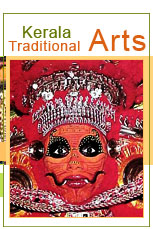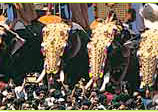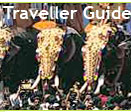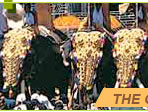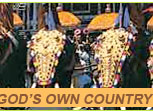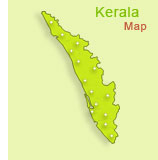Onam is the most popular festival in Kerala. For the Malayalam speaking people, Onam brings nostalgic, yet pleasant and emotions, whether they are home or aboard.
It occurs in the first month of Malayalam calendar, Chingam. Festivities are observed for ten days, from the date of the Asterism,, Atham, to Thiruvonam. This time of the year normally offers fine weather in Kerala, and it is also an excellent occasion for sports and merrymaking
The roots of Onam can be traced to the primitive harvest festival. But, it combines with it the inimitable Indian myth and legend to produce a sweet nostalgia for the ideal society that is believed to have existed in prehistoric Kerala.
According to legend, the ideal Kerala society was ruled by a very kind and; efficient king named Mahabali., affectionately called 'Maveli' by his subjects. the people lived a happy life in equality, prosperity and righteousness. Such an ideal condition aroused certain fears among he gods, for they saw it as a looming threat for their existence. They complained about it to Lord Vishnu, who promised a solution to their problem. Vishnu assumed the form of Vamana, a simpleton sage, and approached king Mahabali with a request for three feet of earth. The magnanimous king gave permission to measure it for himself. Then Vamana assumed his real almighty self and measured the three worlds-Swargaloka (heaven), Bhoomi (earth) and Pathalam (netherworld)- in two feet. Seeing the Lord before him, and his word unfulfilled, Mahabali bowed down in reverence and asked him to measure the third feet on his head.
According to the popular story, Lord Vishnu placed his foot on the king’s head and sent him to the netherworld. It is also mentioned that Vishnu, in appreciation of the king’s qualities, sent him to a place named Suthalam, a better place than Swargaloka.
Nativities of Kerala believe that Mahabali was granted an annual visit to his erstwhile kingdom on Thiruvonam day. On all the ten days of Onam, kids make flower carpets in the front yard to welcome Onathappan, another name for Maveli popular among children. They believe that the just king pays a visit to every individual household. A clay mound is placed at the center of the floral pattern.
Each household makes meticulous arrangements to put on a prosperous look during this season. Even if one is very poor, it is considered very auspicious to celebrate Onam with new cloths and sumptuous meals. For young as well as the old, this is an exciting holy day season.
Most people employed outside their hometown and villages, return home for celebrating Onam. On Thiruvonam day, after the ritual bath, people get ready for the significant day. Some persons visit temples early morning. Presents are distributed to everyone in the family and including other dependents. Everyone wears new cloths, and much importance is attached to the traditional feast served on plantain leaves. After the meal, people engage themselves in some sport or the other. Women find pleasure in Oonjalattam, Thumbithullal, Thiruvathirakali, etc.
Boat races are conducted at various places in Kerala provide good entertainment for tourists.
SIVARATHRI
Sivarathri or the ‘night of Siva’ is celebrated in all parts of India. In Kerala, all Siva temples mark the occasion with all-night Pooja for Siva and entertainments for the devotees. This falls in the Malayalam month of Kumbham (Feb-March).
Sivarathri or Mahasivarathri is the commemoration of the compassionate act of Siva, which protected the world from total annihilation. At the legendary churning of the Ocean of milk to extract amruthu, Vasuki the serpent was used a rope for churning. The serpent, at a certain point of time, spilled its deadly venom Kaalakoodam, which was sufficient to poison and destroy the whole world. Siva, due to his compassion for all life, drunk the every drop of the deadly venom. Parvathy, Siva’s wife, caught hold of his throat in order to stop the poison from reaching his bowels. The Devas closed Siva’s mouth to prevent a spill out. Siva’s throat took on a blue color, and got another name for himself, Neelakanta. Devotees observe fast and keep awake the whole night as a mark of respect for Siva’s compassionate act.
In Kerala, the most important place for Sivarathri is Alwaye. Thousands of devotees converge on the banks of the Periyar river, where the Sivalinga is temporarily installed. They smear themselves with ash after a ritualistic dip in the river. Some make this an occasion for ancestral worship and offer certain rituals standing waist deep in the river. They keep awake the whole night. Early next morning, they take another ritualistic dip in the river, have another darsan of the Lord, and go back to their houses.
In Alwaye, the river banks take on a festive look a week prior to the festival. A temporary market of rural produce will be put up some distance away from the temple. On Sivarathri, cultural and entertainment programs keep the devotees awake till morning.
THIRUVATHIRA
This festive occasion falls on the asterism Thiruvathira in the Malayalam month of Dhanu (December-January)
Though there is no conclusive date of its origin or concord between the various myths associated with it, the festival is auspicious for the worship of Siva. The Adra Darshan of Tamilnadu corresponds to Thiruvathira in Kerala. According to some people, Thiruvathira is the birthday of Siva, but some attach another instance, the perishing of Kamadeva, the god of love, in the fiery vision of Siva’s third eye.
People go to Siva temples early morning for worship. There is normally little festivity at home.
For women of the Nair caste, Thiruvathira is an exceptional time for following certain traditions. They get up early morning and go to a nearby pond or river for a ritualistic bath. It is a pleasant and enjoyable occasion for the ladies, known as Thiruvathirakuli. The girls have fun in water, singing songs and splashing water on each other. They observe certain restrictions in feed also. Instead of the usual rice, they consume preparation of chama (panicum miliaceum) or wheat. Plantain and tender coconuts are also allowed. They chew betel leaves and redden their lips. Among some communities, there is a convention of chewing108 betel during the festival.
Women observe these conventions for seven days beginning on the asterism, Aswathy, and ending on Thiruvathira. They keep awake during that night for propitiating Siva and perform Thiruvathirakali. Oonjalattam is another amusement for the womenfolk.
NAVARATHRI
Navarathri is celebrated all over India during the first nine days in the bright half of Aswina months ()September-October. The last three days-Durgashtami, Mahanavami and Vijayadasami- are very auspicious for Devi worship.
The festival is consecrated to the “Divine Mother”, and she is worshiped in various forms all over the country. In some places, the festival is called Dussehra, and elsewhere, Kalipooja, Durgapooja, Saraswathy pooja, etc. the main pooja is termed Bhuvaneswaripooja, meaning “worship of the universal Mother”.
In Kerala, people perform Saraswathipooja and Ayudhapooja. Saraswathi is the Goddess of learning, and is considered as the fountain-head of all knowledge. On the Durgashtami day, a ceremony called Poojavaipu is performed in the evening. It is done in temples, houses and even in schools. In a specially decorated room, books and pens, and other articles connected with education are placed in front of the image of Goddess Saraswathi, in some place, when the occupation is not connected with letter or arts, one’s everyday utensils, weapons and implements are arranged before the image of the deity. Then a Pooja is offered to the Goddess. As offerings, fruits, beaten rice, jaggery, roasted paddy, etc., are placed before the deity. After pooja, these offerings are offered to the people in attendance.
The lat day is called Vijayadasami. After a poojain the morning, books and implements kept for pooja are removed. The ceremony is called Poojayeduppu. This day is auspicious for making new beginning in any field. Childrens are initiated to the world of letters on this day. Craftsmen and other workers make it a point to do some work or the other, related to their occupation, on this day.
In certain temples, many cultural programs are conducted on these days.
DEEPAVALI
Deepavli or Deewali is a national festival of India, it means the ‘festival of lights’.
It is a commemoration of the great victory of Lord Krishna had over the demon Narakasura. The people of that time are believed to have greeted Krishna with rows of lamps on both sides of the street, when he returned after the victory.
Deepavali falls on the day preceding new moon (Chathurdasi) in the Malayalam month of Thulam (when the sun is in the zodiac, Libra). Astrologically, this is a significant day for the Hindu Merchant communities.
The bright illumination of Deepavali, perhaps, owes its due also to the darkness of the Chathurdasi night.
In Deepavali day, Poojas to Lakshmi. The Goddess of wealth, and Ganapathy are performed. People will rise early morning in their houses and take their ritual bath. Later the family assemble to eat sweets and burst crackers. They make merry the whole day.
In Kerala, Deepavali is shorn off its visual splendor due to the absence of a hereditary merchant community. However, in certain pockets, where there is some population of Gujarathi and Konkanis, Deepavali wears a dazzling look on the street.
CHRITMAS
In urban as well as rural Kerala, where Christians are found, Christmas is celebrated heartily, with an ethnic flavour.
The X’mas star, tree and crib have all found their places in Christian homes all over Kerala. X’mas cake, cards, presents and Santa Claus too have appeared.
Carol singing and nativity plays are presented by boys who go around, from door to door. In churches, midnight masses are said. During the service, a statue of infant Jesus will be placed in the crib. Two other masses will be said during the day.
In Christian homes, the Christmas lunch is an important occasion. All members of the family are supposed to be on time for this lunch.
Here and there, especially in big towns, Christmas parties are organized at some hotel or the other. There is occasion for dance and merrymaking at these parties. On Christmas day, people all over Kerala are all in a happy holiday mood.
MILADI SHARIF
Miladi Sharif is the birthday celebration of Prophet Mohammed. The practice of large scale celebration on this occasion is of recent origin in Kerala.
The most characteristic feature of this occasion is the recital of Maulood, a short biography of the Prophet written in the Arabic language. Muslim Ulemas conduct night lectures during the first twelve days of the month.
In certain parts of Kerala, there is large scale of feeding of the poor. In some places, colorful processions go around towns and villages.
MUHARAM
Muharam is the first month of the Hegira year. The tenth day of the month is important for Muslims, for both Sunni and Shia. It is believed that it was on this day God created Adam and Eve. It is also supposed to be the day when the Pharoah and the Egyptians were drowned in Red sea. The lamentable carnage, at Kerabala took place on this day in 680 A.D. In the carnage, Insman Hussain, the grandson of the prophet, and his followers had an agonizing end.
Muslims observe fast on this day, as advised by the Prophet. In Kerala, Pulikai is a part of the celebrations.
EASTER
Easter is solemnly celebrated in Kerala by Christians of all sects.
The resurrection of Christ is celebrated with great fervor. The abstinence period of 40 days preceding Easter named Lent, the holy weeks comprising Monte Thursday and Good Friday, etc., are conducted solemnly by Christians in churches as well as in their homes. The ‘Hosanna’ feast is conducted with reverence.
In the churches, rituals are held throughout the week. The washing of the feet of twelve old men is conducted in the churches on the Monte Thursday. On the Friday, a statue of Jesus is taken around the nearby places in a procession in the afternoon, which is symbolic of the act. This statue is laid in church, and the Christians pour into pay respects.
On the eve of Easter, there will be midnight masses in the churches, during the night, church bells toll announcing the resurrection of Jesus. In some churches devotees light candles from a lamp lit and blessed in the church and take it to their houses. This is symbolic of the light of resurrection.
Special significance is given to the Easter lunch. Otherwise, this festival is rather quiet and very solemn.
VISHU
Though its origin is bereft of religious association, this festival is observed solemnly and without the usual pomp and show and merry-making associated with other festivals. It occurs on the first day of the Malayalam month, Medam, unlike other festivals which are observed according to lunar asterisms. This day is the astronomical New Year day and it is celebrated as such. It is on this day that the sun crosses the equator.
People of Kerala consider this as an auspicious day to begin afresh. They believe that the fortunes for the year depend upon the nature of the object one sees first in the morning of the Vishu day. On the previous day itself. They prepare the Kani, an ominous set-up comprising Uruli, a wide circular bell-metal vessel, with some raw rice covered with a clean cloth. On top of it is placed golden colored cucumber, betel leaves, betel nuts, metal mirror, yellow Konna flowers (cassia fistula), a book of palm leaves and sometimes, an idol of SreeKrishna.
Traditional metal lamps are placed near it. Early morning, usually the eldest female member gets up and after lighting the lamp of the Kani, leads each member of the household blindfold and opens their eyes before the Kani. This ensues each one an auspicious new year.
JEWISH FESTIVALS
Jews of Kerala have been the part and parcel of Kerala society since the first century, when they are believed to have started emigrating after the destruction of the second temple of Jerusalem in 72 A.D. there have been later migrations in the 15th and 16th centuries from Europe. Even today, there are Jewish communities in certain pockets along the Kerala coast.
Members of this community, though miniscule in number, observe all Jewish festivals.
Passover is an important festival of the Jews. It is called the feast of the unleavened bread and is the commemoration of the deliverance of Jews from Egyptian slavery. It falls in April or May, beginning on the 14th of Nisan.
Pentecost is another festival observed in May-June. It has an agricultural and historical significance.
The feast of Taberncle is another festival of Jews. Tabernacle originally meant a tent used as sanctuary during the exodus from Egypt. During the feast, they make temporary booths covered with palm leaves and decorated with citrus and other fruits.
The Jews also celebrate their New Year, which falls in September/October. It is a solemn season for self assessment and judgment in the life of a Jew. The Day of Atonement following the New Year is the most solemn day in the Jewish Calendar. Not a morsel of food or a drop of water will pass the lips of observant Jews from sun set of the previous day till after nightfall of the next day.
Hanukka or the ‘festival of lights’ is another popular celebration of the Jews.
BAKRID (Idul-Azha)
Bakrid is called the festival of sacrifice, and is one of the two important festivals of Islam. This is observed by Muslims all over the world. It is the commemoration of Abraham’s willingness to offer his only son as a sacrifice at God’s command.
The day dawns with a resounding of Thakbir (Alahu Akabr), the declaration that God is great. People dressed in their best clothes and proceed to Id-Gah, open space set apart for public prayer. After the ceremonial Id prayer, the leader addresses the congregation, exhorting them to be conscious of their duties to God. After prayers, the gathering exchange greetings and hug each other.
At homes, hearty feasts and social visits are characteristics of Muslims in Kerala. In this occasion, special meeting are organized in several places.
RAMADAN (Idul-Fitr )
This important Islamic festival is known as Idul-Fitr. Ramadan is the ninth month of Arabic Calendar, which is a fasting period for Muslims all over the world. They observe fasting during the day time and spend the major part of the night in devotion and prayer during this month.
When the month of Ramadan ends, and the crescent appears on the western horizon, the Idul-Fitr festival is celebrated. It commences with the distribution of food for the poor people. Early morning, people visit mosques or Id-Gah for prayers. After the ceremony by he Imam, they go home, visit friends and relatives. In Kerala, Muslim women, dressed in their best clothes and wearing jewellery, pay visits to neighbors or engage in entertainments.
:: More Festivals
Thiruvananthapuram
¤ Feast of Christ at Madre Deus Church, Vettukadu.
Highlights - Special devotional rites and Eucharistic procession. (Third week of November).
¤ Handicrafts Heritage- Kerala at Kanakakkunnu Palace. Conducted in connect with the All India Handicraft Week Celebrations.
Highlights - Display and sale of meticulously crafted articles unique to the State. (December).
¤ Paramparya, the Ashtamudi arts and crafts festival at Asramam Maidan.
Highlights Exhibition of the traditional arts, crafts and architectural themes of Kerala. (December).
¤ Agri Fest at Kanakakkaunnu Palace. largest agricultural fair in the State.
Hightlights - Cultural shows and Fashion shows. (January).
¤ Swathi Sangeethoutsavam at Kuthiramalika Palace. Annual classical music festival organised in honour of king - Swathi Thirunal.
Highlights An august gathering of eminent musicians from across. (January).
¤ Utsavam at Paripally Kodimootil Sree Bhadrakali Temple. Elephants offered as ritual offering.
Highlights Cultural programmes and Gajamela (elephant pageant). (February).
¤ Utsavam at Sreekandeswaram Temple.
Highlights Kodiyettam, Ezhunallathu, Pallivetta, Kathakali and Ottanthuyllal (December).
¤ Utsavam at Janardhana Swamy Temple, Varkala.
Highlights Rituals, Pallivetta, Arattu procession and Kathakali. (March).
Pathanamthitta
¤ Mandala Pooja at Sree Dharamsastha Temple, Sabrimala. The day marks the end of 41 day period of austerities and prayer. (December).
¤ Gajamela at Parthasarathy Temple, Adoor.
Hightlights Grand elephants procession. (January).
¤ Thaipooya Mahotsavam at Sree Subramanya Swamy Temple.
Highlights Thaipooya kavadiyattam and Chuttuvilakku. (January).
¤ Utsavam at Sree Parthasarathy Temple, Aranmula.
Highlights Kodiyettam, Ritual arts, Kathakali, Pallivetta and Arattu. (January).
¤ Utsavam at Poruvazhi Malandam Temple.
Highlights Folk arts and Kettukazhcha procession with kaala (bull motif), kuthira vela (horse motif) and decorated temple chariot. (March).
Alappuzha
¤ Utsavam at Kandiyur Mahadeva Temple.
Hightlights Kodiyettam, Arattu and Kathakali and Ottanthullal. (December).
¤ Utsavam at Sree Karthyayini Temple.
Highlights Kodiyettam, Arattu, Elephant pageantry, Panchavadyam, Chedamelam, Ritual arts and Kathakali. (March).
¤ Utsavam at Sree Krishna Swamy Temple. Daily offering of palpayasam (milk sweet).
Highlights Kodiyettam, Velakali, Padayani, Community feast, Ritual procession, Ambanattu Panikkar Varavu and Pallivetta (March).
¤ Champakulam Boat Race (Vallamkali) at Harippad.
Highlights Ceremonial water procession, Spectacular water floats, Vanchipattu and the chundanvallom (snake boat) race. (July).
¤ Nehru Trophy Boat Race, Punnamadakayal. On the second Saturday of August every year.
Highlights Ceremonial water procession, Spectacular water floats, Decorated boats, Vanchipattu, Races of small country crafts and the chundanvallom (snake boat) race (August).
Kottayam
¤ Mahotsavam at Thrichenganoor Mahadeva Temple.
Highlights Processions, Arattu and Classical and folk arts. (December)
Ernakulam
¤ Utsavam at Mahadeva Temple.
Highlights Ritual procession, Kathakali, Classical music recitals and Ashtami (19th) (November).
¤ Utsavam at Sree Poornathrayeesa Temple.
Highlights Kanikka edal (offerings placed in a golden pot), Kathakali, Chakyarkoothu, Ottanthullal and Music concerts. (December)
¤ Mahotsavam at Mahadeva Temple.
Highlights Deepakazhcha, illumination of traditional lamps, Ottamthullal, Chakyarkoothu, Kurathiyattam and Elephant pageants. (December)
¤ Tourism Week Celebration - A secular festival that brings together the thirteen communities living in Kochi.
Highlights Food festival, Procession of theme floats, Gajamela (elephant pageants), Music concerts, Jalamela (water fiestas), Cultural programmes and Boat race (December).
¤ Indira Gandhi Boat Race on the Kochi backwaters. (December)
¤ Utsavam at Siva Temple.
Highlights Seeveli, Panchavadyam, Pakalpooram, Kathakali, Music concerts and Arattu (January).
International Contemporary Dance Festival. Assemblage of artistes from India, Europe and the Far East (January).
¤ Gramam An entire Kerala village is recreated during this ten day long festival.
Highlights Arts and crafts fair, Kathakali, Thiruvathirakali, Mohiniattam, Oppana, Kalaripayattu, Sarpapattu, Theyyam, Panchavadyam, Chakyarkoothu and Ottanthullal (Februay).
¤ Utsavam at Sree Rajarajeswari Temple.
Highlights Arattu, Makamthozhal (special rite)- Chottanikkara Makam, Pooram on the eight day, Grand fireworks, Art forms and Cultural performances (February).
¤ Kakkoor Kalavayal A traditional post harvest festival of the peasants of Kakkoor.
Highlights Exhibition of agricultural products, implements, and other traditional crafts, Folk arts, Music concerts, Elephants processions and Bullock race (March).
¤ Bharani festival at Sree Kurumba Bhagavathy Temple.
Highlights Cultural programmes and Devotional rites. (April).
¤ Athachamayam marks the beginning of the Onam festival.
Highlights Elephant procession, Colourful floats, Musical ensembles and Ritual and folk art forms (September).
¤ Aluva Sivarathiri at Siva Temple.
Highlights Night long reading of the puranas, Rural trade fair, Cultural programmes and Vavubali (ritual in honour of the forefathers) at dawn (March).
Thrissur
¤ Thaipooya Mahotsavam at Sree Maheswara Temple.
Highlights Kavadiyattam, Elephant procession, Karakattam and Mayilattam (January).
¤ Utsavam at Sreekrishna Temple, Guruvayoor.
Highlights Rituals, Elephant race, Cultural programmes and Krishnanattam (March).
¤ Machattu Mamangam at Machattu Thiruvanikavu Temple.
Highlights Kuthirakolams (motifs of horses) given as offering, Chendamelam, Pandimelam and All night Pooram on the concluding day. (February)
¤ Pulikali (Tiger dance) at the Swaraj Ground is part of the Onam celebrations. (September)
Palakkad
¤ Pooram at Sree Chinakkathoor Bhagavathy Temple.
Highlights Elephant procession, Panchavadyam, Velattu, Thira/ Theyyam, Pootham, Kaalavela, Kuthiravela, Aandi Vedan, Karivela, Tholpavakoothu and Kumbhamkali (February).
¤ Pooram at Pariyanampetta Bhagavathy Temple.
Highlights Tholpavakoothu, Kalamezhuthupattu, Pootham, Thira, Karivela, Kaalavela, Kuthiravela, Kathakali, Chakyarkoothu and Elephant procession (February).
Kozhikode
¤ Malabar Pepper Fest. An annual event for spice traders when gourmets and gastronomic experts explore the spice coast. (February).
¤ Kondotti Nercha at Kondotti Mosque. The Valia Nercha (great vow) festival attracts large crowds of devotees. (March)
Kannur
¤ Annual eight day Utsavam at Jagannatha Temple.
Highlights Religious conferences, Elephant processions, Fireworks display and Cultural programmes (February). |

